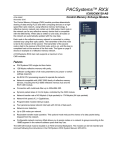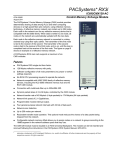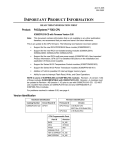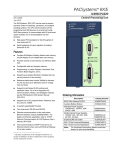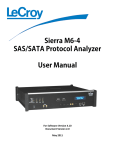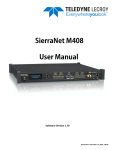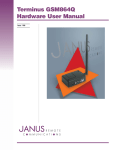Download PACSystems RX3i Control Memory Xchange Module
Transcript
PACSystems™ RX3i GFK-2506A January 2010 IC695CMX128-AB Control Memory Xchange Module The Control Memory Xchange (CMX) module provides deterministic sharing of data among PLCs and other computing devices on a highspeed fiber optic network, using reflective memory technology. A reflective memory network can contain up to 256 nodes. Each node in the network can be any reflective memory device that is compatible with the 5565 family. When data is written to one node, all nodes on the network are automatically updated with the new data. Each node in the reflective memory network is connected in a daisychained loop using fiber optic cables. The transmitter of the first node is tied to the receiver of the second. The transmitter of the second node is tied to the receiver of the third node, and so on, until the loop is completed back at the receiver of the first node. The figure on page 5 shows an example of a reflective memory network. OK CONFIG SIG DETECT OWN DATA CMX128 NODE A PACSystems RX3i main rack supports a maximum of six CMX modules. Features ■ PACSystems RX3i single slot form factor. ■ 128 Mbytes reflective memory with parity. ■ Software configuration of all node parameters (no jumper or switch settings required). ■ No RX3i CPU processing required to operate the network. ■ Network-compatible with VMIC 5565 family of reflective memory devices, including the ACC-5595 reflective memory hub and the RX7i CMX module. TX (FRONT) RX (BACK) ■ Connection with multimode fiber up to 300m/984.25ft. ■ Dynamic packet sizes of 4 to 64 bytes, controlled by the CMX module. ■ Network transfer rate of 43 Mbyte/s (4 byte packets) to 174 Mbyte/s (64 byte packets) ■ Network link speed of 2.1 Gigabits/sec. ■ Programmable module interrupt output. ■ Four general-purpose network interrupts with 32 bits of data each. ■ Network error detection. ■ Up to 256 nodes per network. ■ Redundant transfer mode operation. This optional mode reduces the chance of a data packet being dropped from the network. ■ Configurable network memory offset allows you to assign nodes on a network to groups according to the 16MB segment in the network address space that they use. The CMX128 module must be located in an RX3i Universal Backplane. The module can be hot-inserted and removed following the instructions in the PACSystems RX3i System Manual, GFK-2314. 2 RX3i Control Memory Xchange Module GFK-2506A Specifications Packet size Transfer rate User memory Input power (from RX3i power supply) Dynamic packet sizes of 4 to 64 bytes, automatically controlled by the CMX module Network link speed of 2.1 Gbits/sec 128MB SDRAM 660 mA @ +3.3 VDC 253 mA @ +5 VDC Connectors ■ Fiber optic LC type, conforms to IEC 61754-20 ■ Zirconium ceramic ferrule ■ Insertion loss: 0.35 dB (maximum) ■ Return loss: -30dB Refer to the PACSystems RX3i System Manual, GFK-2314, for product standards and general specifications. Installation in Hazardous Locations EQUIPMENT LABELED WITH REFERENCE TO CLASS I, GROUPS A, B, C & D, DIV. 2 HAZARDOUS LOCATIONS IS SUITABLE FOR USE IN CLASS I, DIVISION 2, GROUPS A, B, C, D OR NONHAZARDOUS LOCATIONS ONLY WARNING - EXPLOSION HAZARD - SUBSTITUTION OF COMPONENTS MAY IMPAIR SUITABILITY FOR CLASS I, DIVISION 2; WARNING - EXPLOSION HAZARD - WHEN IN HAZARDOUS LOCATIONS, TURN OFF POWER BEFORE REPLACING OR WIRING MODULES; AND WARNING - EXPLOSION HAZARD - DO NOT CONNECT OR DISCONNECT EQUIPMENT UNLESS POWER HAS BEEN SWITCHED OFF OR THE AREA IS KNOWN TO BE NONHAZARDOUS. Related Publications PACSystems Memory Xchange Modules User’s Manual, GFK-2300 PACSystems RX3i System Manual, GFK-2314 PACSystems CPU Reference Manual, GFK-2222 Proficy™ Machine Edition Logic Developer-PLC Getting Started, GFK-1918 Ordering Information Description Catalog Number Control Memory Xchange Module for RX3i Fiber Optic Cables IC695CMX128 VMICBL-000-F5-0xx, where 0xx distinguishes different lengths VMIACC-5595 Reflective Memory Hub 3 RX3i Control Memory Xchange Module GFK-2506A Release Information This is the initial release of the RX3i Control Memory Xchange Module. Release History Release Firmware Version Date IC695CMX128-AB 1.02 IC695CMX128-AA 1.00 Upgrade Kit Comments October 2009 82A1512-MS10-000-A1 See “Problems Resolved.” September 2008 N/A Initial Release Functional Compatibility The CMX128 requires the following versions for configuration and operation. Subject Description Programmer Version Requirements Proficy® Machine Edition Logic Developer 5.80 (released build 4541) or later is required to use the RX3i IC695CMX128 modules. RX3i CPU PACSystems RX3i CPU firmware version 5.50 or later Rack Location The CMX128 must be located in the main RX3i rack. IC695CMX128 modules require a PCI backplane, which is not available on IC694CHSxxx expansion bases. Problems Resolved by Release 1.02 Subject Description Memory read parity check CMX/RMX memory read parity was checked only on DWORDs aligned to QWORD boundary. An error existed in the parity check where half of the memory was not being checked for parity. (Only the lower 32-bit DWORD for each 64-bit QWORD would be parity checked, ignoring the parity check on the upper 32-bits.) CMX128 module power up An error existed in the CMX transceiver control that allowed network traffic to be received while the module was powering up and executing internal initialization. Occasionally, this traffic could interfere with the memory controller initialization, causing it to lock up and preventing the module from completing power-up. The failure occurred only when a Reflective Memory Hub was connected to the CMX. Eliminated possible metastability issue in the DDR2 memory interface. An issue existed in the CMX DDR2 memory interface that could cause the memory data path to be in a metastable state. If this occurred, invalid data could be written to or read from the DDR2 memory. 4 RX3i Control Memory Xchange Module GFK-2506A Restrictions and Open Issues in this Release Subject RX3i CMX/RMX does not disable transmitter when the CPU goes to Stop/Halt mode. The LCSR status bit is not turning ON after LISR turns ON when Interrupt (Sync Loss) is generated SVC_REQ 17 is not supported CPU320 compatibility issue with firmware version 5.50 Description For IC695CMX128 modules and IC695RMX128 modules not used as redundancy links, the automatic transmitter disable feature currently does not work correctly when a controller goes to Stop/Halt mode. When the CPU goes to Stop/Halt mode or fails and the automatic transmitter disable feature is enabled, the fiber optic transmitter should be turned off, breaking the reflective memory link. When the feature is disabled the transmitter remains ON and the reflective memory link will not be broken. When enabled, the automatic transmitter disable feature does not work when the CPU goes into Stop/Halt mode (such as after a software watchdog trip or multi-bit ECC error detection), leaving the fiber optic transmitter ON. The fiber optic transmitter is properly disabled if the CPU fails or is lost (for instance the CPU hardware is removed, the CPU experiences a hardware watchdog event, or displays a blink code such as a page fault). This user-configurable feature is enabled by default. It may be disabled by clearing bit 12 with a BUS_WRITE to region 3, offset 0x440. The LCSR bit is not latched to the ON state (indicating sync loss) and should not be used for sync loss detection. The LISR bit should be used for detecting sync loss. SVC_REQ 17 is not supported to mask or unmask module interrupts on RX3i CPUs. There is currently no way to identify which module interrupt should be masked on RX3i. To turn off interrupts, use the normal interrupt disabling mechanism described in the IC695CMX128 user's manual. For details, see “Dynamic Masking of Interrupts” in the PACSystems Memory Xchange Modules User’s Manual, GFK-2300. When using CPU320 with firmware version 5.50, occasionally, a backplane reset of the CMX128 module will cause it to become nonresponsive. This problem is corrected in CPU320 firmware version 5.51. 5 RX3i Control Memory Xchange Module GFK-2506A CMX Operation The CMX module initially powers up in an unconfigured state with its optical transmitter and receiver disabled. The module cannot operate on a network until the RX3i CPU has delivered a hardware configuration to the module. Basic operating functions are configured using Machine Edition – Logic Developer PLC. You can configure the following parameters in the hardware configuration: Node ID, Redundant Transfer Mode, Rogue Master, Network Memory Offset, and Interrupt enable. Additional functions beyond the basic read and write operations, including enabling interrupts, reading interrupt status, enabling parity, and reading parity errors, can be performed by user logic. For details on accessing these advanced functions, refer to the PACSystems Memory Xchange Modules User’s Manual, GFK-2300. Once the CMX has been configured, a transfer of data over the network can be initiated by writing to the reflective memory region through the backplane. The CMX forms the data into variable length packets sized from 4 to 64 bytes, which it transmits over the fiber-optic network to the receiver of the next node. Whenever a packet is received, the CMX evaluates the packet. If the packet is valid and did not originate on this node, it is accepted. If, however, the data packet is invalid or if it originated at this node, it is discarded. The receiving node writes the data into the local reflective memory and simultaneously transmits the data to the next node on the network. The process is repeated until the data returns to the originating node, where it is removed from the network. Sample Reflective Memory Network The seven-node network in the following illustration consists of six RX3i CMX modules and a PCI WorkStation with a VMIPCI 5565 reflective memory board. PCI WorkStation with VMIPCI 5565 reflective memory board 6 RX3i Control Memory Xchange Module GFK-2506A Optical Transceiver The optical transceiver, which is located on the bottom of the module, has two “LC” type fiber optic ports. The port labeled “TX” is the transmitter and the port labeled “RX” is the receiver. CMX modules are networked together using either simplex (single fiber) or duplex (dual fiber) multimode fiber optic cables. The specific cable construction depends on your operating environment. For details on cables, refer to the PACSystems Memory Xchange Modules User’s Manual, GFK-2300. LEDs All front panel LED indicators are green. LED Label Optical Transceiver (bottom view) Description OK ON indicates the CMX module and the CPU are functioning properly. CONFIG* ON indicates the module is configured. TX RX SIG DETECT ON indicates the receiver is detecting a fiber optic signal. OWN DATA ON indicates the module has received its own data packet from the network at least once. * A reflective memory hub can be used to bypass a node that is not configured. Example of SIG DETECT Operation -- Node 5 Not Configured Configured: CONFIG ON SIG DETECT ON (if upstream node is configured) Upstream Nodes RX Node 4 TX Not Configured: CONFIG OFF SIG DETECT ON Configured: CONFIG ON SIG DETECT OFF RX RX Node 5 TX Node 6 TX Downstream Nodes






